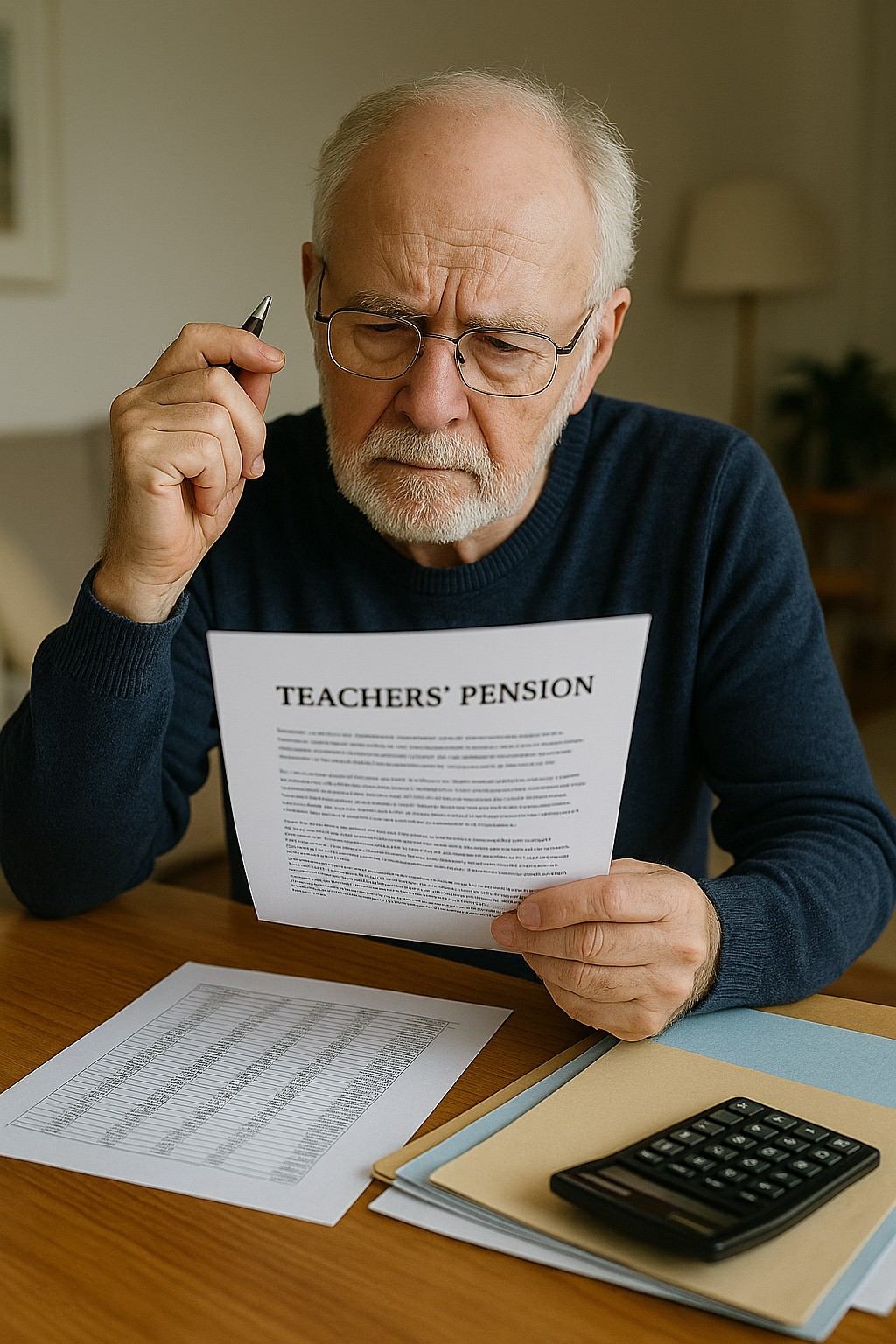Teacher Pensions & Retirement Considerations
What Teachers Need to Know About Their Pensions

Friday 24th July 2026 | Estimated reading time: 20 mins
Note: This article provides general information on teachers’ pensions and recent changes. It is not financial advice, but an outline of factors to consider when preparing for retirement.
For many decades, the Teachers’ Pension Scheme (TPS) operated on a final salary basis. Under this system, a teacher’s pension was calculated based on their salary near retirement (typically either their salary in the last year of service or the average of their best three consecutive years in the final ten, adjusted for inflation) [neu.org.uk]. This provided a pension linked to the peak earnings of a teacher’s career. Until 2015, all teachers in state schools (both primary and secondary) built up benefits in the final salary scheme [neu.org.uk].
Major Reform in 2015: In April 2015, the TPS closed its final salary scheme for most members and launched the Career Average Revalued Earnings (CARE) scheme [neu.org.uk]. Under CARE, each year’s earnings contribute a fraction (1/57) to your pension, with yearly amounts increased by inflation [educationhub.blog.gov.uk]. This differs from the old system, which used final salary and years of service.
Most teachers moved to the new scheme in 2015, while new entrants joined CARE automatically. Older teachers near retirement got transitional protections - some stayed longer in the final salary scheme before switching. This created several member categories, depending on age and service [unbiased.co.uk].
Normal Pension Age Changes: One key difference that came with the new scheme was the Normal Pension Age (NPA). In the final salary TPS, NPA was 60 for those who joined before 2007, or 65 for those who entered service from 1 January 2007 onward [teacherspensions.co.uk]. The 2015 career average scheme set the NPA equal to the teacher’s State Pension Age (with a minimum of 65) [teacherspensions.co.uk]. In practice, this means many teachers will have a later retirement age for full pension benefits under the career average scheme (e.g. 66 or 67, rising in line with state pension age) compared to the earlier schemes. A teacher with service in both schemes will have more than one NPA – their final salary benefits can be taken at the earlier age (60 or 65 depending on their service), while their career average benefits are only payable in full at their state pension age [edapt.org.uk]. (Of course, teachers can choose to take pensions early, but with an actuarial reduction for early retirement – more on that later.)
Indexation: Another historical change to note is how pensions are increased for inflation. Since 2011, the TPS (like other public-sector schemes) has used the Consumer Prices Index (CPI) for uprating pensions each year in retirement, rather than the Retail Prices Index (RPI). All TPS pensions, whether final salary or career average, are index-linked – once in payment they rise each year with inflation so that the annual pension increases with the cost of living [educationhub.blog.gov.uk]. This ensures retirees’ incomes keep pace with inflation (CPI), although the switch from typically-higher RPI to CPI in 2011 slightly reduced the generosity of inflation uprating.
2015–2022 Transitional Period: From 2015 to 2022, the TPS ran both the legacy final salary scheme (for service before 2015 or protected members) and the new career average scheme. Any final salary benefits earned before the change are kept and will be calculated on your final (or best three-year average) salary at retirement - this is called the “final salary link” [neu.org.uk] [teacherspensions.co.uk]. This means higher earnings later in your career still boost your final salary pension, even though the scheme has closed.
The McCloud Judgment and Closing of the Final Salary Scheme
In 2018, the McCloud judgment ruled that transitional protections in the 2015 public-sector pension reforms were discriminatory, as they allowed older members to remain in the final salary scheme while younger (newer) colleagues were moved into the career average scheme.
To address this, the government:
- Closed the final salary scheme to all active members in April 2022, moving everyone into the career average (CARE) scheme.
- Introduced a “Deferred Choice Underpin”: eligible teachers (in service before April 2012 and still active in 2015) will be offered a choice at retirement to receive either final salary or CARE benefits for the 2015–2022 remedy period, whichever is more beneficial.
Teachers with service before and after 2015 will have split pensions, combining preserved final salary benefits (based on your final salary at retirement) and CARE benefits (based on yearly revalued earnings). This ensures no teacher loses out due to the transition.
The remedy will apply retrospectively to those who retired or left during the remedy period. It may result in higher costs for the scheme, which are being met through increased employer and employee contributions.
Changes in Contribution Rates for Teachers and Government
Teacher pension contributions have evolved significantly:
- Historically, teachers paid a flat 6.4%, and employers paid around 14.1%.
- From 2012, teacher contributions became tiered by salary, rising to between 7.4% and 12% (2025–26 rates), depending on earnings.
- Employers’ contributions also increased: from 16.48% in 2019 to 28.68% in April 2024, partly to fund McCloud-related costs.
- Part-time teachers now contribute based on actual salary (not full-time equivalent), ensuring fairness.
While higher contributions slightly reduce take-home pay, the scheme remains one of the most secure and valuable defined-benefit pensions in the public sector.
Implications for Teachers Nearing Retirement

If you are a teacher nearing retirement, the various scheme changes mean you may have to navigate multiple pension elements and rules. Here are some key considerations:
Mixed final salary and career average benefits: As noted, many mid-career and senior teachers will have a portion of their pension from the final salary scheme and a portion from the career average scheme (especially if you started teaching before 2015). The final salary portion is preserved and will be calculated based on your final full-time equivalent salary when you retire, not the moment you left the old scheme [neu.org.uk]. This is good news – any pay rises (or inflation increases) you receive up until retirement will boost the final salary pension segment. When you retire, Teachers’ Pensions will do the math for both parts. You’ll essentially get two sets of benefits that add up to your total pension.
Different pension ages for different slices: You may have one pension age for the final salary part (60 or 65) and a later age for the career average part (your State Pension Age, e.g. 66 or 67). You don’t have to take both together - for example, you could take your final salary pension at 60, then defer the career average part. To take your final salary pension early, you usually need to leave teaching or opt out of the scheme, as you can’t draw a TPS pension while still contributing. Taking the career average pension before its normal age leads to reductions. It’s worth checking your statements or the TPS portal to see your options, and many teachers seek guidance on the best timing.
Early retirement and reductions: Apart from normal pension age considerations, any teacher can choose to retire early (from age 55, rising to 57 in 2028) and take a reduced pension. This is formally called Actuarially Reduced Benefits (ARB) in the TPS. The reduction reflects the fact that you’ll be drawing the pension longer. If you are contemplating retiring a few years before your NPA, it’s worth looking at the reduction factors (available on TPS website calculators) to see the trade-off. For example, retiring two or three years early may only reduce the pension by a manageable percentage, whereas retiring a decade early has a much larger cut. Keep in mind that if you have both final salary and CARE portions and you choose to take benefits early, each portion’s reduction is calculated based on its own NPA. (Taking the final salary part early, before 60/65, would incur a reduction on that part as well.)
Protection of final salary rights: One positive implication of the scheme evolution is that any pension you earned under final salary terms is protected by law. The McCloud remedy ensures that if final salary would give you a better benefit for 2015–2022, you can have that. Also, your final salary service remains linked to your actual final pay. So if you continue working into your 60s, your final salary pension portion will be based on whatever your highest salary ends up being. If you leave teaching and later return, note that a break in service of over five years would break the final salary link – meaning the final salary benefits would then be based on your salary at the time of the break, not your later salary [teacherspensions.co.uk]. So, teachers near retirement who are considering a long career break should be aware of that rule.
Lump sum and commutation: Under the pre-2007 final salary arrangement, teachers received an automatic tax-free lump sum (typically 3x the annual pension) in addition to the pension [neu.org.uk]. Newer schemes (post-2007 final salary NPA65 section and the 2015 CARE scheme) do not automatically include a lump sum, but all members have the option to commute part of their pension for a lump sum at retirement. This means you can trade some annual pension to get a one-off tax-free lump sum (subject to limits). The conversion rate is generous (for example, in TPS £1 of annual pension can be swapped for £12 of lump sum) [neu.org.uk]. Teachers nearing retirement should think about whether they want a larger lump sum upfront (for e.g. paying off a mortgage or other plans) or prefer to maximize their regular pension income. It’s a personal choice – the scheme provides calculators to illustrate the options [neu.org.uk].
In summary, the changes to the TPS mean that teachers close to retirement will have more moving parts to consider: final salary vs career average portions, different retirement ages, and possibly a choice of scheme benefits for the remedy years. It’s wise to read the communications from Teachers’ Pensions and use the available tools (like the online benefits statement and pension calculators) to map out your expected pension. And while this guide isn’t financial advice, some may benefit from consulting an independent advisor, especially if considering complex decisions like phased retirement or taking benefits early.
Full-Time vs Part-Time Employment as Retirement Approaches

Many teachers reduce their hours or move to part-time roles as they transition toward retirement. It’s important to understand how part-time work affects your pension:
Impact on pension accrual: In the final salary scheme, your pension is based on your length of service and final average salary. Part-time work means your service is counted pro-rata - e.g., two years at 50% (0.5 FTE) count as one year of pensionable service [neu.org.uk]. Importantly, the salary used in your pension calculation remains the full-time equivalent (FTE), not your reduced pay. So, part-time slows the build-up of service years, but doesn’t reduce the salary used. In the career average scheme, your pension is based on what you actually earn each year. If you work half-time, you earn and accrue half the pension for that year. In summary, part-time work reduces the pace of pension build-up, but can be a worthwhile choice for work-life balance before retirement.
Phased retirement option: The TPS allows phased retirement, letting you draw part of your pension while working part-time [neu.org.uk]. To qualify, you must be at least 55 (57 from 2028) and reduce your salary by at least 20% for 12 months - such as cutting your hours or taking a less demanding role. For example, you could work fewer hours, take up to 75% of your pension, and still earn part-time pay. You can use phased retirement up to twice if you have final salary benefits, or three times if only in the career average scheme. This option lets you gradually step back from work, easing the financial impact as you transition towards full retirement. Employer agreement and a formal application are required.
Final years’ salary considerations: In the final salary scheme, going part-time late in your career won’t lower the salary used in your pension if your full-time equivalent (FTE) pay stays high. For example, if you’re an AHT on £60,000 FTE and go to 0.5 FTE, your actual pay drops to £30,000, but your pension is still based on £60,000 (plus inflation) [neu.org.uk]; you just accrue fewer months of service. Taking a lower-grade job with a lower FTE salary could affect your final salary pension, unless a previous higher salary is used (the best three-year average in the last 10 years is considered). In the career average scheme, each year stands alone, so a lower salary only reduces accruals for those years.
Continued contributions: Whether full- or part-time, you keep building pension benefits if you’re employed and haven’t opted out. Part-time teachers pay contributions based on their actual salary, not the full-time equivalent, so pay less and earn less pension each year [teacherspensions.co.uk]. For example, a 0.5 FTE teacher with a £50k FTE salary earns £25k, paying a lower 7.4% rate. This change ensures fairness for part-timers.
Going part-time before retirement can help with work-life balance, and the scheme is flexible. Use TPS calculators to plan, and notify Teachers’ Pensions of any changes so your record stays correct.
Recent Reforms and What They Mean for Your Pension

Beyond the historical shifts and the McCloud remedy, a few other recent changes and ongoing factors are worth noting for teachers’ retirement planning:
State Pension Age and TPS linkage: The UK State Pension Age (SPA) is rising - currently 66, moving to 67 by 2028, and likely 68 in future. The TPS career average scheme’s Normal Pension Age matches your SPA [teacherspensions.co.uk], so most younger teachers can only take their full TPS pension at 67 or 68. Early retirement is possible, but with reductions. Working longer means a bigger pension, with more years for your credits to grow, but plan for retirement in your late 60s to receive full benefits.
Removal of the Lifetime Allowance charge: The 2023 Budget removed the Lifetime Allowance cap on tax - free pension savings (previously just over £1 million). Now, there’s no tax penalty for teachers whose pension grows above this level. This mostly affects senior teachers with long service. The Annual Allowance - how much you can build up each year tax-free - was also increased to £60,000 in 2023. Most teachers won’t reach this unless they get a large pay rise or big service boost. Overall, these changes mean fewer unexpected tax bills for teachers, but higher earners should still keep an eye on their Annual Allowance.
Cost-of-living adjustments: TPS pensions rise each year in line with CPI inflation, helping protect your pension’s value [educationhub.blog.gov.uk]. Recent high inflation led to bigger pension increases in April 2023 and 2024. For those nearing retirement, high inflation also boosts career average revaluations (CPI + 1.6% for active members) and can increase indexed past salaries for final salary calculations. The key point: your pension will keep pace with inflation once in payment - a valuable safeguard in uncertain times.
Not a substitute for personal saving: The Teachers’ Pension is a solid base for retirement, but may not provide the lifestyle you want - especially if you retire early. The move to a career average scheme can mean lower pensions for those with late-career pay rises, and higher pension ages may delay retirement. Many teachers top up their TPS with AVCs, personal pensions, or other savings. It’s sensible to review your TPS projections regularly and consider extra saving if you want to retire early or boost your retirement income.
Stay informed on scheme updates: The TPS is complex and can change due to government decisions, court cases, or valuations [wesleyan.co.uk]. Features like the “cost control mechanism” may alter benefits or contributions if scheme costs change, and recent updates have included changes after the McCloud remedy. Stay up to date by reading official communications from Teachers’ Pensions, the Department for Education, or your union.
In conclusion, teacher pensions in the UK have undergone significant evolution – from a straightforward final salary scheme to a more complex career average scheme with multiple transitional nuances. The government and judiciary interventions (like the McCloud judgment) have aimed to ensure fairness, but also introduced new choices for members. As you approach retirement, take the time to understand your pension benefits: know which portions of your service fall under which rules, be aware of your retirement age(s), and consider how changing work patterns (full-time to part-time, or continuing work past the earliest pension age) might affect your plans. The TPS is a secure, inflation-proofed benefit that will form a cornerstone of most teachers’ retirement finances. By understanding the scheme’s evolution and current features, you can make informed decisions about your retirement timing and lifestyle.
Remember, this overview is for information only – for personalised advice, consider speaking with a qualified financial adviser or using the free guidance available (for example, through MoneyHelper or Teachers’ Pensions). With the right preparation, you can approach retirement with confidence, knowing how your pension has been built and what options you have.
Sources:
National Education Union – Teachers’ Pension Scheme: Final salary scheme
(Historical scheme details and 2015 reforms)
Department for Education – Teachers’ Pensions: What You Need to Know
(Overview of 2022 changes and contributions)
Teachers’ Pensions Official Site – When Can You Retire?
(Normal Pension Ages, minimum retirement age, and final salary link)
National Education Union – TPS Age Discrimination FAQ
(McCloud remedy explanation and cost implications)
Wesleyan – Changes to the Teachers’ Pension Scheme
(McCloud remedy rollout and contribution rate increase in 2024)
National Education Union – TPS: Final salary scheme (NEU guidance)
(Effects of part-time work and phased retirement rules in TPS)
Unbiased – Teachers’ Pension Scheme: Everything You Need to Know
(Latest contribution tiers for 2025/26 and confirmation of employer rate)
Be sure to check out our blog archive for more insights on teacher pay and finance, and stay tuned for further updates.